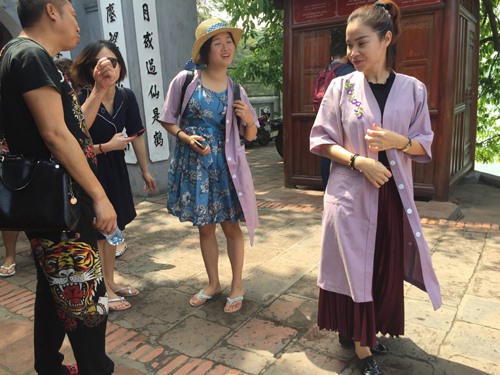

People who visit Viet Nam from other countries often like to see religious places. Very often they do not know that it is not nice to be dressed too casually when doing so.
 |
| The garment is for both male and female with different sizes. |
Very often they do not know that it is not nice to be dressed too casually when doing so.
Some temples and similar religious places are now offering extra clothes to tourists to wear when they visit.
This way the tourists do not upset anyone and the people and religious people can feel happy about having visitors.
By Hồng Vân
It is a custom or a tradition, all over the world, that people dress with a certain decorum when visiting places of worship, whether they are temples and pagodas, or churches or mosques.
That decorum and respect is maintained whether one goes to pray or simply to admire the architecture or cultural aspects of the place of worship, the rituals, and so on.
In Việt Nam, pagodas and temples are places where the Buddha and various deities are worshipped. They are also places where Buddhist monks teach Buddhism, its precepts and its way of life to the devout and others who are interested in learning. They are usually tranquil, serene and solemn places.
When people visit these places, the devotion and respect they have is also reflected in what they wear.
However, there are many tourists who, either because of a lack of awareness or because of an attitude of disrespect and indifference, visit places of worship in this country wearing shorts, sleeveless shirts and other inappropriate attire.
Rather than ban such people from entering the places of worship, the capital city of Hà Nội has launched an initiative – lending visitors a long-sleeved shirt or dress that stretches to below the knee.
“I am totally OK with wearing this. When I travel to some other countries, they also offer tourists such garments. I want to make sure that I don’t disrespect the local culture,” said Pam Robertson, an Australian tourist, accepting a garment from the staff of Ngọc Sơn Temple.
“We are on a tour to Hà Nội and didn’t plan to visit the temple, so I didn’t dress properly. It’s convenient that I can borrow the long shirt here and continue my visit,” said Nguyễn Mỹ An from HCM City.
At Ngọc Sơn Temple and many other tourist attractions of Hà Nội, visitors can see a booth with a pile of neat and clean garments that staff offer to both local and international visitors who are not attired appropriately.
Temple staff guide any visitor with inappropriate attire to the booth and offer to lend them the garments for free. All they need to do is to deposit some form of ID. In general, visitors are happy to accept.
According to Nguyễn Đức Vượng, head of the Ngọc Sơn Relic Site Management Board, about 100 long shirts are available for tourists to borrow everyday.
The garment, which comes in different sizes, can be worn by both men and women. They come in a light purple shade, have V shaped necks, half-sleeves and some simple patterns.
The introduction of this garment is one of several initiatives taken to implement the Code of Conduct in Public Places that municipal officials released in March. The code requires people to wear “decent” clothes in public places.
Ngọc Sơn Temple is the first place in Hà Nội to implement the initiative. It will soon be emulated at other sites, including the Temple of Literature, Kiệu Temple, former Hỏa Lò Prison and the historical relic at 48 Hàng Ngang. The style of garment offered will differ according to the nature of the site, officials said.
“It is not necessary to make the garment uniform because each region has its own cultural features and each relic has its own characteristics.
“What is the most important is that tourists understand the need to wear proper clothes in places that are deemed sacred or carry other cultural or historical importance – a custom of Việt Nam,” Phạm Trung Lương, former deputy head of Việt Nam Tourism Research and Development, told the online Dan Tri newspaper.
He also said that while there was no general standard for the garments, they must be clean and aesthetic. “Visitors cannot be asked to wear garments that smell or don’t fit,” he said.
Earlier Cửa Ông Temple in the northern province of Quảng Ninh, Linh Ứng Pagoda in the central city of Đà Nẵng and the Ponagar Tower in the central city of Nha Trang had begun offering the garment. The Ponagar Tower offers about 50, while Linh Ứng Pagoda has nearly 1,000 sets of clothes for visitors to use every day. — VNS
It is a custom or a tradition, all over the world, that people dress with a certain decorum when visiting places of worship, whether they are temples and pagodas, or churches or mosques.
Decorum is the behaviour that people must keep in order to remain respectable.
That decorum and respect is maintained whether one goes to pray or simply to admire the architecture or cultural aspects of the place of worship, the rituals, and so on.
If something is maintained it is kept up.
Architecture means the design of buildings.
Rituals are ceremonies that are held on special occasions and follow a special procedure.
In Việt Nam, pagodas and temples are places where the Buddha and various deities are worshipped.
Deities are gods.
They are also places where Buddhist monks teach Buddhism, its precepts and its way of life to the devout and others who are interested in learning.
Monks are men who have devoted their lives to the service of a religion.
Precepts are rules that encourage people to act in a certain way no matter what they might actually think.
They are usually tranquil, serene and solemn places.
Tranquil means still.
Serene means calm.
Solemn means important.
When people visit these places, the devotion and respect they have is also reflected in what they wear.
Devotion means loyalty.
Reflected means shown.
However, there are many tourists who, either because of a lack of awareness or because of an attitude of disrespect and indifference, visit places of worship in this country wearing shorts, sleeveless shirts and other inappropriate attire.
Lack of awareness means not knowing about something.
Disrespect is the opposite of respect.
Indifference means lack of interest.
Inappropriate attire means the wrong kind of clothing.
Rather than ban such people from entering the places of worship, the capital city of Hà Nội has launched an initiative – lending visitors a long-sleeved shirt or dress that stretches to below the knee.
To ban people from entering places of worship means to not allow them to enter these places.
An initiative is an action.
Lending means giving somebody something to use that they must later return.
“When I travel to some other countries, they also offer tourists such garments.”
Garments are clothes.
“It’s convenient that I can borrow the long shirt here and continue my visit,” said Nguyễn Mỹ An from HCM City.
Convenient means fitting in easily with your plans.
To borrow means to be given something by somebody else to use that must later be returned to its owner.
At Ngọc Sơn Temple and many other tourist attractions of Hà Nội, visitors can see a booth with a pile of neat and clean garments that staff offer to both local and international visitors who are not attired appropriately.
A booth is a kiosk.
All they need to do is to deposit some form of ID.
To deposit, in this case, means to hand something over while borrowing something that is returned once you have given back what you have borrowed
ID is short for identity document.
The introduction of this garment is one of several initiatives taken to implement the Code of Conduct in Public Places that municipal officials released in March.
A code of conduct is a set of rules that explains the kind of behaviour that is expected within an organisation.
It will soon be emulated at other sites, including the Temple of Literature, Kiệu Temple, former Hỏa Lò Prison and the historical relic at 48 Hàng Ngang.
Emulated, in this case, means copied.
A relic is something left behind from the past.
He also said that while there was no general standard for the garments, they must be clean and aesthetic.
Aesthetic means pleasing to the eye, in other words pretty.
State whether the following sentences are true, or false:
© Duncan Guy/Learn the News/ Viet Nam News 2017
1. False; 2. False; 3. True; 4. False; 5. True.









